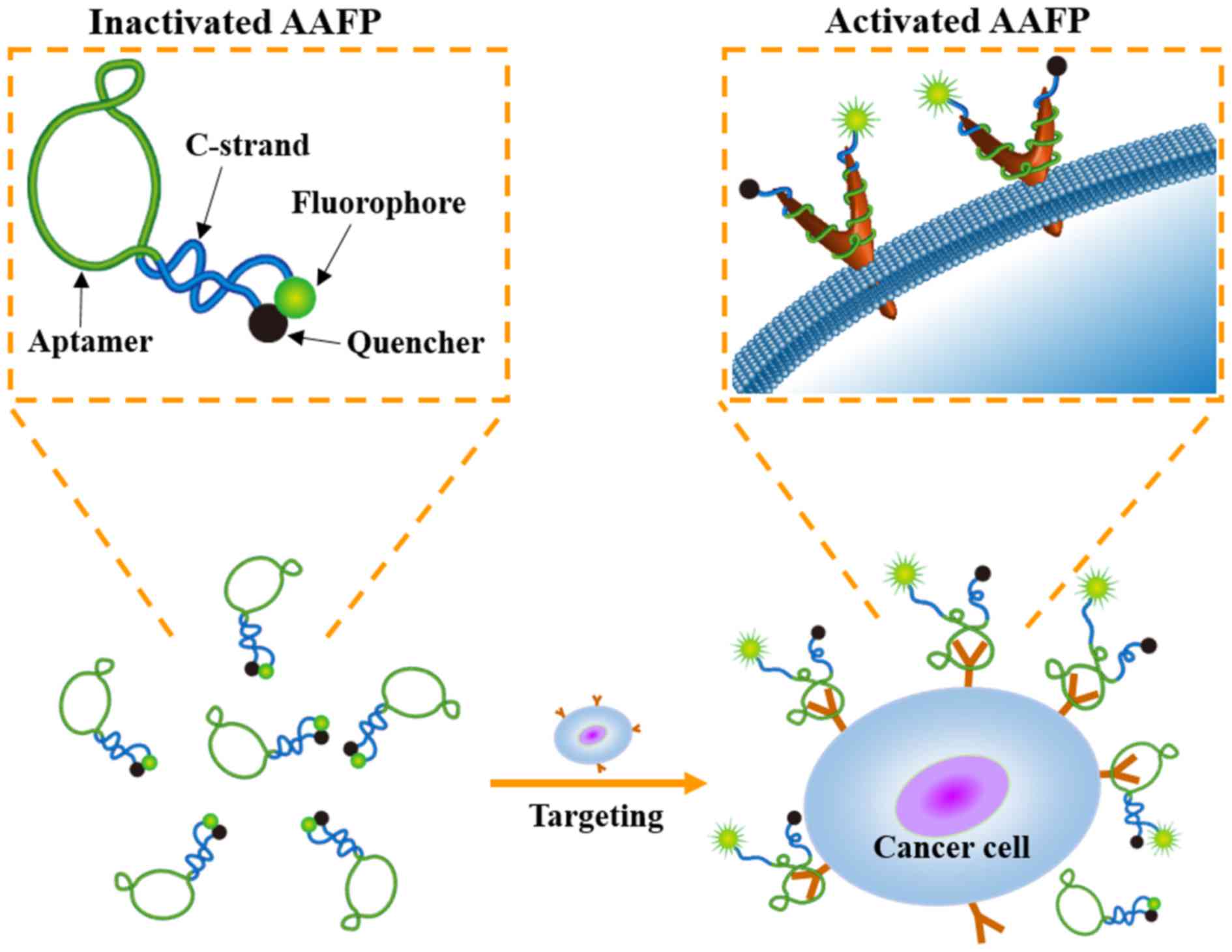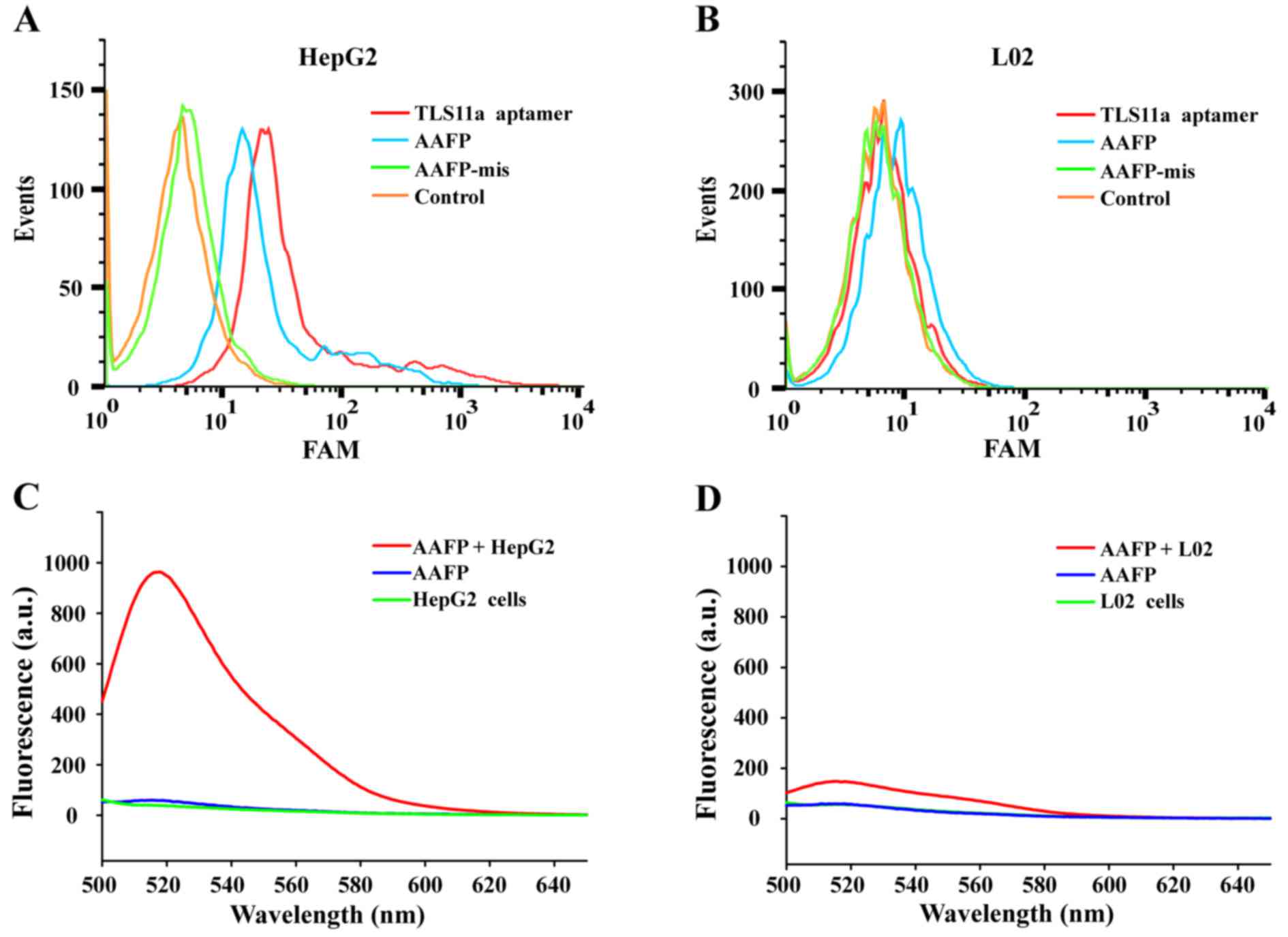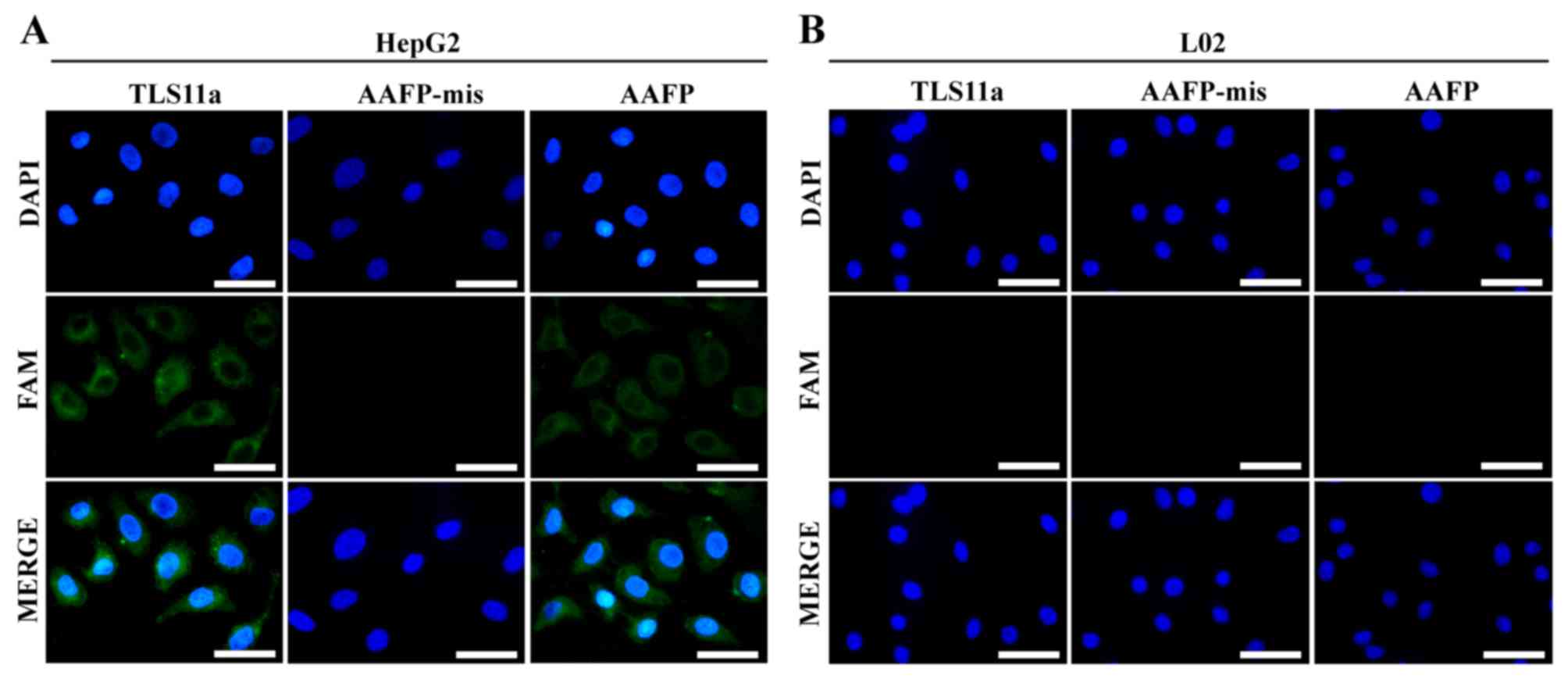|
1
|
Siegel RL, Miller KD and Jemal A: Cancer
statistics, 2015. CA Cancer J Clin. 65:5–29. 2015. View Article : Google Scholar : PubMed/NCBI
|
|
2
|
Li C, Meng Y, Wang S, Qian M, Wang J, Lu W
and Huang R: Mesoporous carbon nanospheres featured fluorescent
aptasensor for multiple diagnosis of cancer in vitro and in vivo.
ACS Nano. 9:12096–12103. 2015. View Article : Google Scholar : PubMed/NCBI
|
|
3
|
Kobayashi H, Longmire MR, Ogawa M, Choyke
PL and Kawamoto S: Multiplexed imaging in cancer diagnosis:
Applications and future advances. Lancet Oncol. 11:589–595. 2010.
View Article : Google Scholar : PubMed/NCBI
|
|
4
|
Chen TT, Tian X, Liu CL, Ge J, Chu X and
Li Y: Fluorescence activation imaging of cytochrome c
released from mitochondria using aptameric nanosensor. J Am Chem
Soc. 137:982–989. 2015. View Article : Google Scholar : PubMed/NCBI
|
|
5
|
Zhang M, Chakraborty SK, Sampath P, Rojas
JJ, Hou W, Saurabh S, Thorne SH, Bruchez MP and Waggoner AS:
Fluoromodule-based reporter/probes designed for in vivo
fluorescence imaging. J Clin Invest. 125:3915–3927. 2015.
View Article : Google Scholar : PubMed/NCBI
|
|
6
|
Hou Y, Zhou J, Gao Z, Sun X, Liu C,
Shangguan D, Yang W and Gao M: Protease-activated ratiometric
fluorescent probe for pH mapping of malignant tumors. ACS Nano.
9:3199–3205. 2015. View Article : Google Scholar : PubMed/NCBI
|
|
7
|
Sonn GA, Behesnilian AS, Jiang ZK,
Zettlitz KA, Lepin EJ, Bentolila LA, Knowles SM, Lawrence D, Wu AM
and Reiter RE: Fluorescent image-guided surgery with an
anti-prostate stem cell antigen (PSCA) diabody enables targeted
resection of mouse prostate cancer xenografts in real time. Clin
Cancer Res. 22:1403–1412. 2016. View Article : Google Scholar : PubMed/NCBI
|
|
8
|
Hussain T and Nguyen QT: Molecular imaging
for cancer diagnosis and surgery. Adv Drug Deliv Rev. 66:90–100.
2014. View Article : Google Scholar : PubMed/NCBI
|
|
9
|
Jung YK, Woo MA, Soh HT and Park HG:
Aptamer-based cell imaging reagents capable of fluorescence
switching. Chem Commun. 50:12329–12332. 2014. View Article : Google Scholar
|
|
10
|
Lao YH, Phua KK and Leong KW: Aptamer
nanomedicine for cancer therapeutics: Barriers and potential for
translation. ACS Nano. 9:2235–2254. 2015. View Article : Google Scholar : PubMed/NCBI
|
|
11
|
Ellington AD and Szostak JW: In vitro
selection of RNA molecules that bind specific ligands. Nature.
346:818–822. 1990. View
Article : Google Scholar : PubMed/NCBI
|
|
12
|
Hu Z, Lai Z, He J, Huang X, Hou X, Zhao Y
and Lu X: Research progress on cell-SELEX. Cell Commun. 2:57–66.
2015.
|
|
13
|
Tan W, Donovan MJ and Jiang J: Aptamers
from cell-based selection for bioanalytical applications. Chem Rev.
113:2842–2862. 2013. View Article : Google Scholar : PubMed/NCBI
|
|
14
|
Wang AZ and Farokhzad OC: Current progress
of aptamer-based molecular imaging. J Nucl Med. 55:353–356. 2014.
View Article : Google Scholar : PubMed/NCBI
|
|
15
|
Shi H, He X, Wang K, Wu X, Ye X, Guo Q,
Tan W, Qing Z, Yang X and Zhou B: Activatable aptamer probe for
contrast-enhanced in vivo cancer imaging based on cell membrane
protein-triggered conformation alteration. Proc Natl Acad Sci USA.
108:3900–3905. 2011. View Article : Google Scholar : PubMed/NCBI
|
|
16
|
Meng HM, Liu H, Kuai H, Peng R, Mo L and
Zhang XB: Aptamer-integrated DNA nanostructures for biosensing,
bioimaging and cancer therapy. Chem Soc Rev. 45:2583–2602. 2016.
View Article : Google Scholar : PubMed/NCBI
|
|
17
|
Shangguan D, Meng L, Cao ZC, Xiao Z, Fang
X, Li Y, Cardona D, Witek RP, Liu C and Tan W: Identification of
liver cancer-specific aptamers using whole live cells. Anal Chem.
80:721–728. 2008. View Article : Google Scholar : PubMed/NCBI
|
|
18
|
Zhang C, Ji X, Zhang Y, Zhou G, Ke X, Wang
H, Tinnefeld P and He Z: One-pot synthesized aptamer-functionalized
CdTe:Zn2+ quantum dots for tumor-targeted fluorescence
imaging in vitro and in vivo. Anal Chem. 85:5843–5849. 2013.
View Article : Google Scholar : PubMed/NCBI
|
|
19
|
Yu Y, Duan S, He J, Liang W, Su J, Zhu J,
Hu N, Zhao Y and Lu X: Highly sensitive detection of leukemia cells
based on aptamer and quantum dots. Oncol Rep. 36:886–892.
2016.PubMed/NCBI
|
|
20
|
Lee CH, Rajendran R, Jeong MS, Ko HY, Joo
JY, Cho S, Chang YW and Kim S: Bioimaging of targeting cancers
using aptamer-conjugated carbon nanodots. Chem Commun.
49:6543–6545. 2013. View Article : Google Scholar
|
|
21
|
Shi H, Tang Z, Kim Y, Nie H, Huang YF, He
X, Deng K, Wang K and Tan W: In vivo fluorescence imaging of tumors
using molecular aptamers generated by cell-SELEX. Chem Asian J.
5:2209–2213. 2010. View Article : Google Scholar : PubMed/NCBI
|
|
22
|
Tan J, Yang N, Hu Z, Su J, Zhong J, Yang
Y, Yu Y, Zhu J, Xue D, Huang Y, et al: Aptamer-functionalized
fluorescent silica nanoparticles for highly sensitive detection of
leukemia cells. Nanoscale Res Lett. 11:2982016. View Article : Google Scholar : PubMed/NCBI
|
|
23
|
Meng L, Yang L, Zhao X, Zhang L, Zhu H,
Liu C and Tan W: Targeted delivery of chemotherapy agents using a
liver cancer-specific aptamer. PLoS One. 7:e334342012. View Article : Google Scholar : PubMed/NCBI
|
|
24
|
Kashefi-Kheyrabadi L, Mehrgardi MA,
Wiechec E, Turner AP and Tiwari A: Ultrasensitive detection of
human liver hepatocellular carcinoma cells using a label-free
aptasensor. Anal Chem. 86:4956–4960. 2014. View Article : Google Scholar : PubMed/NCBI
|
|
25
|
Pu Y, Liu Z, Lu Y, Yuan P, Liu J, Yu B,
Wang G, Yang CJ, Liu H and Tan W: Using DNA aptamer probe for
immunostaining of cancer frozen tissues. Anal Chem. 87:1919–1924.
2015. View Article : Google Scholar : PubMed/NCBI
|
|
26
|
Yang Y, Huang J, Yang X, Quan K, Xie N, Ou
M, Tang J and Wang K: Aptamer-based FRET nanoflares for imaging
potassium ions in living cells. Chem Commun. 52:11386–11389. 2016.
View Article : Google Scholar
|
|
27
|
Zhang L, Cui P, Zhang B and Gao F:
Aptamer-based turn-on detection of thrombin in biological fluids
based on efficient phosphorescence energy transfer from Mn-doped
ZnS quantum dots to carbon nanodots. Chemistry. 19:9242–9250. 2013.
View Article : Google Scholar : PubMed/NCBI
|
|
28
|
Wu X, Zhao Z, Bai H, Fu T, Yang C, Hu X,
Liu Q, Champanhac C, Teng IT, Ye M, et al: DNA aptamer selected
against pancreatic ductal adenocarcinoma for in vivo imaging and
clinical tissue recognition. Theranostics. 5:985–994. 2015.
View Article : Google Scholar : PubMed/NCBI
|
|
29
|
Wu X, Chen J, Wu M and Zhao JX: Aptamers:
Active targeting ligands for cancer diagnosis and therapy.
Theranostics. 5:322–344. 2015. View Article : Google Scholar : PubMed/NCBI
|
|
30
|
Park JY, Lee TS, Song IH, Cho YL, Chae JR,
Yun M, Kang H, Lee JH, Lim JH, Cho WG, et al: Hybridization-based
aptamer labeling using complementary oligonucleotide platform for
PET and optical imaging. Biomaterials. 100:143–151. 2016.
View Article : Google Scholar : PubMed/NCBI
|
|
31
|
Shangguan D, Tang Z, Mallikaratchy P, Xiao
Z and Tan W: Optimization and modifications of aptamers selected
from live cancer cell lines. ChemBioChem. 8:603–606. 2007.
View Article : Google Scholar : PubMed/NCBI
|
|
32
|
Shigdar S, Macdonald J, O'Connor M, Wang
T, Xiang D, Al Shamaileh H, Qiao L, Wei M, Zhou SF, Zhu Y, et al:
Aptamers as theranostic agents: Modifications, serum stability and
functionalisation. Sensors. 13:13624–13637. 2013. View Article : Google Scholar : PubMed/NCBI
|















